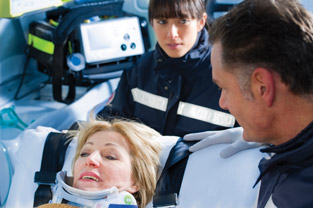
In Case of Emergency: ASTM Standards Respond to Disaster
ASTM Standards Across a Spectrum of Committees Respond to Disaster
Natural disasters present enormous challenges to those attempting to minimize potential damage from future events, as well as to those dealing with the aftermath. While technical standards cannot prevent natural disasters, they are used to ensure greater safety and security before disasters occur and to provide needed assistance in the wake of events.
Standards that deal with disaster situations are in place across a spectrum of ASTM committees. Here are a few examples.
Standards under the jurisdiction of ASTM Committee E05 on Fire Standards are an integral part of fire safety. These include E2726/E2726M, Test Method for Evaluating the Fire-Test-Response of Deck Structures to Burning Brands; E2707, Test Method for Determining Fire Penetration of Exterior Wall Assemblies Using a Direct Flame Impingement Exposure; and E108, Test Methods for Fire Tests of Roof Coverings.
Committee E06 on Performance of Buildings develops standards that play an important role throughout the building industry. Subcommittee E06.25 on Whole Buildings and Facilities is responsible for E2557, Practice for Probable Maximum Loss (PML) Evaluations for Earthquake Due-Diligence Assessments, a tool for those who are undertaking the seismic risk assessment of properties. Subcommittee E06.51 on Performance of Windows, Doors, Skylights and Curtain Walls has developed standards that can test the performance of windows in severe weather-related situations, particularly hurricanes. Also under the jurisdiction of E06 is a standard that would aid in the evacuation of buildings disabled by a disaster: E2484, Specification for Multi-Story Building External Evacuation Controlled Descent Devices, developed by E06.77 on High Rise Building External Evacuation Devices.
Committee E54 on Homeland Security develops standards that focus on infrastructure protection, decontamination, security controls, threat and vulnerability assessment, and chemical, biological, radiological and nuclear sensors and detectors. Nearly all E54 standards deal with emergency situations. Two specific examples under the jurisdiction of Subcommittee E54.02 on Emergency Preparedness, Training and Procedures are E2413, Guide for Hospital Preparedness and Response, which is intended to assist hospital leaders in the design, planning and response to be undertaken during an event that necessitates the activation of an emergency operations plan; and E2668, Guide for Emergency Operations Center (EOC) Development, which is a blueprint for the development of an EOC. Also under the jurisdiction of E54 is E2458, Practices for Bulk Sample Collection and Swab Sample Collection of Visible Powders Suspected of Being Biological Agents from Nonporous Surfaces, a standard spurred by anthrax incidents after the attacks of Sept. 11, 2001.
Committee F30 on Emergency Medical Services develops standards that are relevant in any emergency situation. Subcommittee F30.02 focuses on training of EMS personnel, while F30.01 maintains standards that cover EMS equipment, including extremity splints, spinal immobilization devices, oxygen delivery systems and specialized aircraft used to transport patients.
Search and rescue operations are always important but take on an extra sense of urgency after a disaster has occurred. Committee F32 on Search and Rescue works closely with the National Association for Search and Rescue to promote knowledge through standards that cover a wide range of search and rescue activities. Education is provided through the standards developed by Subcommittee F32.03 on Personnel, Training and Education, while testing and maintenance of rescue equipment such as climbing harnesses, flotation devices, rescue litters, anchorages and rope rescue systems is emphasized in the standards developed by F32.01.
 SN Home
SN Home Archive
Archive Advertisers
Advertisers Masthead
Masthead RateCard
RateCard Subscribe
Subscribe Email Editor
Email Editor